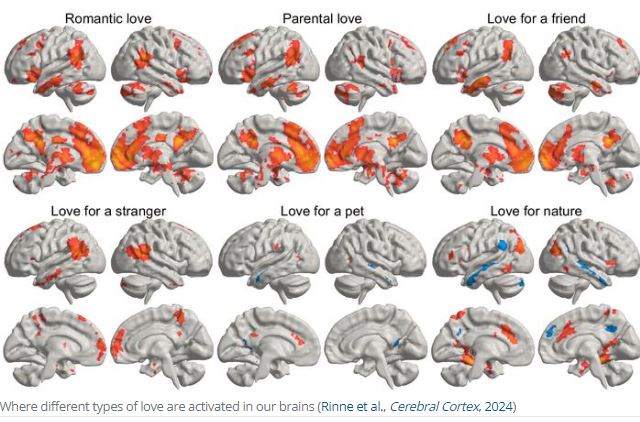Helsinki/Finland: A groundbreaking study from Aalto University in Finland, led by philosopher Pärttyli Rinne, has revealed new insights into how our brains process various forms of love. Using advanced brain scans, researchers have identified unique neural pathways associated with romantic, parental, and platonic love, including affection for pets and nature. The findings, reported by Cerebral Cortex, offer a deeper understanding of the complex nature of human emotions. Photo Credits: Cerebral Cortex
The study reveals that parental love generates the most intense brain activity. Unlike other forms of love, it activates the striatum, a brain region crucial for planning and decision-making, and the thalamus, which plays a role in consciousness and alertness. "In parental love, there was activation deep in the brain's reward system in the striatum area while imagining love, and this was not seen for any other kind of love," explains Rinne. This heightened activity aligns with the significant effort and planning involved in raising a child.

Romantic love also engages many of the same brain areas as parental love but does not activate the striatum as strongly. Meanwhile, love for friends, nature, pets, and strangers activates the brain's reward centres, including the superior frontal gyrus and the cingulate gyrus. However, the intensity and pattern of activation differ based on the type of love. For example, love for strangers activates underlying brain processes similar to those in close relationships, though less intensely.
Interestingly, love for nature sparked the most distinct brain activity compared to other types of love, though it still lit up the cingulate gyrus, a common feature in social love types. Additionally, brain scans revealed that pet owners showed neural patterns more similar to interpersonal love compared to those without pets.
Participants in the study were asked to imagine neutral and emotionally charged scenarios while undergoing fMRI scans. This approach allowed researchers to compare brain activity associated with different types of love. The study included 55 healthy individuals from Finland, aged 28 to 53, all of whom were in relationships, had at least one child, and approximately half lived with a pet.
The study, published in Cerebral Cortex, is the largest of its kind but acknowledges the need for further research across different cultures to fully understand how cultural and demographic factors influence the experience and neural correlates of love. The researchers hope these insights will lead to improved treatments for attachment disorders and other mental health conditions.
"Our results provide a more comprehensive picture of the brain activity associated with different types of love than previous research," Rinne concludes. "Further cross-cultural studies are necessary to explore how various factors affect our understanding of love."